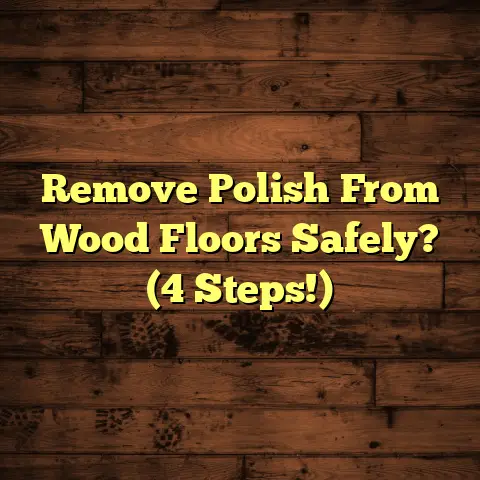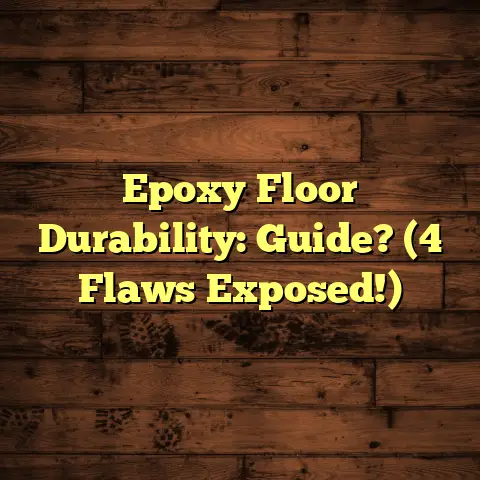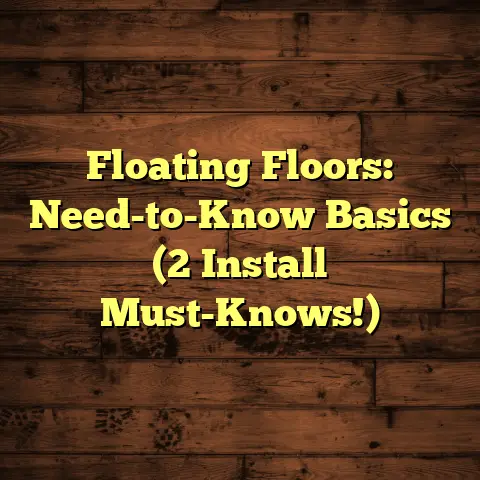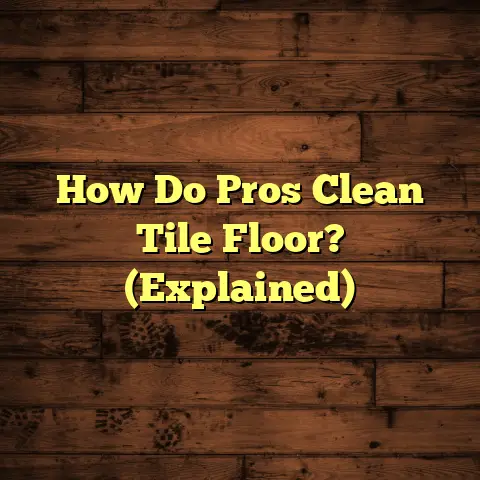Best Shed Floor Coverings? (4 Top Options Now!)
Ever walked into a shed and thought, “Wow, this floor is… well, something“?
I’m here to tell you that your shed floor doesn’t have to be an afterthought.
In fact, the right floor covering can totally transform your shed, making it more functional, durable, and even dare I say, stylish.
A good floor protects against moisture, damage, and wear, while making the space way more usable and appealing.
Think of it like this: a solid foundation (literally!) sets the stage for everything else you do in your shed, whether it’s woodworking, gardening, or just storing your prized collection of garden gnomes.
But what’s the “best” option? Well, that’s the million-dollar question, isn’t it?
It really depends on your specific needs, how you plan to use your shed, and even the climate you live in.
For instance, a woodworker will need something different than someone storing lawn equipment.
And someone in a rainy climate will have different needs than someone in a dry one.
That’s why I’m going to walk you through four top options for shed floor coverings.
I’ll break down the pros and cons, installation tips, and even give you some real-life examples.
So, grab a cup of coffee (or your favorite beverage), and let’s dive in!
1. Vinyl Flooring: Waterproof Wonder
Overview of Vinyl Flooring
Okay, let’s start with vinyl flooring. What is it, exactly?
Well, it’s a synthetic flooring material made from polyvinyl chloride (PVC) and other compounds.
You’ve probably seen it in kitchens, bathrooms, and other high-traffic areas.
It’s known for being durable, water- resistant, and relatively inexpensive.
But why is it a popular choice for sheds?
Well, those same qualities that make it great for homes also make it fantastic for sheds.
Plus, it comes in a huge variety of designs and styles, so you can really customize the look of your shed.
Advantages of Vinyl Flooring
Let’s talk about the good stuff. Why should you consider vinyl flooring for your shed?
-
Waterproof and Moisture Resistant: This is a big one, especially if you live in a damp climate or plan to store things that could leak. Vinyl is virtually impervious to water, so you don’t have to worry about rot or mold.
-
Easy to Clean and Maintain: Got a muddy mess? Spilled some paint? No problem! Vinyl is super easy to clean with just a damp mop and some mild detergent. I’ve even hosed mine down before!
-
Variety of Designs and Styles: Want a wood look without the hassle of real wood? How about a cool tile pattern? Vinyl has you covered. You can find it in sheets, tiles, or planks, and in just about any color or design you can imagine.
Installation Process
Alright, let’s get down to the nitty-gritty. How do you actually install vinyl flooring in a shed?
Here’s a step-by-step guide:
-
Prepare the Subfloor: Make sure your subfloor (usually plywood or OSB) is clean, dry, and level. Fill any holes or cracks with wood filler and sand it smooth.
-
Measure and Cut: Measure your shed floor and cut the vinyl flooring to size. Leave a little extra around the edges for trimming.
-
Dry Fit: Lay the vinyl in place without adhesive to make sure it fits properly. Trim any excess with a utility knife.
-
Apply Adhesive (if needed): Some vinyl flooring has a peel-and-stick backing, while others require adhesive. If you’re using adhesive, apply it evenly to the subfloor with a trowel.
-
Lay the Vinyl: Carefully lay the vinyl in place, starting at one edge and working your way across. Use a roller to smooth out any bubbles or wrinkles.
-
Trim and Finish: Trim the excess vinyl around the edges with a utility knife. Install baseboards or trim to cover the edges and give it a finished look.
Tools and Materials You’ll Need:
- Vinyl flooring (sheets, tiles, or planks)
- Utility knife
- Measuring tape
- Straight edge
- Trowel (if using adhesive)
- Adhesive (if needed)
- Roller
- Wood filler (if needed)
- Sandpaper (if needed)
- Baseboards or trim
Cost Analysis
So, how much will this set you back? Here’s a general breakdown of the costs:
-
Material Costs: Vinyl flooring can range from \$1 to \$5 per square foot, depending on the quality and style.
-
Installation Costs: If you’re doing it yourself, you’ll only need to factor in the cost of tools and materials. If you hire a professional, expect to pay \$2 to \$5 per square foot for labor.
Example:
Let’s say you have a 10×12 shed (120 square feet). If you choose vinyl flooring that costs \$3 per square foot, the material cost would be \$360. If you hire a professional to install it at \$3 per square foot, the labor cost would also be \$360. So, the total cost would be \$720.
Real-Life Examples
I’ve seen vinyl flooring work wonders in sheds.
Take my buddy, Bob. He uses his shed as a workshop for his woodworking hobby.
He installed vinyl flooring a few years ago, and he says it’s been a game-changer.
“I used to worry about sawdust and spills ruining the floor,” he told me.
“But now, I just sweep it up or wipe it down, and it looks good as new.”
Another friend, Sarah, uses her shed as a potting shed for her gardening hobby.
She chose a vinyl flooring with a tile pattern, and it looks fantastic.
“It’s so easy to clean up after I’ve been working with soil and plants,” she said.
“Plus, it just makes the shed feel more like a cozy little space.”
2. Plywood: Strong and Sturdy
Overview of Plywood as a Shed Floor Covering
Now, let’s move on to plywood. This is a classic choice for shed floors, and for good reason.
Plywood is an engineered wood product made from thin layers of wood veneer glued together.
It’s strong, durable, and relatively inexpensive, making it a popular choice for construction projects of all kinds.
But why is it a good option for shed floors?
Well, it provides a solid and stable surface for storing heavy equipment, tools, and other items.
Plus, it can be treated to resist moisture and rot, which is essential for sheds.
Advantages of Plywood
What are the benefits of using plywood for your shed floor?
-
Sturdy and Strong: Plywood can handle a lot of weight, making it ideal for storing heavy items like lawnmowers, tools, and equipment.
-
Can be Treated for Moisture Resistance: While plywood isn’t naturally waterproof, you can treat it with sealants or preservatives to make it more resistant to moisture and rot.
-
Easy to Replace Individual Panels if Damaged: If a section of your plywood floor gets damaged, you can easily replace just that panel without having to replace the entire floor.
Installation Process
How do you install plywood flooring in a shed? Here’s a step-by-step guide:
-
Prepare the Floor Joists: Make sure your floor joists are properly spaced and level. This is crucial for a stable and even floor.
-
Cut the Plywood: Measure your shed floor and cut the plywood sheets to size. Use a circular saw or a jigsaw for accurate cuts.
-
Lay the Plywood: Lay the plywood sheets over the floor joists, staggering the seams for added strength.
-
Secure the Plywood: Use screws or nails to secure the plywood to the floor joists. Make sure the fasteners are long enough to penetrate the joists.
-
Seal the Plywood: Apply a sealant or preservative to the plywood to protect it from moisture and rot. You can use a brush, roller, or sprayer to apply the sealant.
Tips for Securing and Sealing:
- Use construction adhesive in addition to screws or nails for extra holding power.
- Apply multiple coats of sealant for maximum protection.
- Pay special attention to the edges of the plywood, as these are the most vulnerable to moisture.
Cost Analysis
Let’s talk about the cost of plywood flooring.
-
Material Costs: Plywood can range from \$0.50 to \$2 per square foot, depending on the thickness and grade.
-
Treatment Costs: Sealants and preservatives can cost anywhere from \$20 to \$50 per gallon, depending on the brand and type.
Factors Influencing Cost:
-
Plywood Thickness: Thicker plywood is more expensive but also stronger and more durable.
-
Plywood Grade: Higher-grade plywood has fewer defects and is more expensive.
-
Treatment Options: Some sealants and preservatives are more expensive than others.
Real-Life Examples
I know plenty of shed owners who swear by plywood flooring.
My neighbor, Tom, uses his shed as a workshop for his metalworking hobby.
He installed plywood flooring several years ago, and it’s held up great.
“I’ve dropped heavy tools and equipment on it, and it hasn’t even dented,” he said.
“Plus, it’s easy to clean up metal shavings and debris.”
Another friend, Lisa, uses her shed as a storage space for her gardening supplies.
She treated her plywood floor with a waterproof sealant, and it’s protected against moisture and spills.
“I don’t have to worry about my potting soil or fertilizer ruining the floor,” she said.
3. Rubber Flooring: Soft and Safe
Overview of Rubber Flooring
Alright, let’s talk about rubber flooring. This is a great option if you’re looking for something that’s comfortable, safe, and durable.
Rubber flooring is made from recycled or synthetic rubber and comes in a variety of forms, including rolls, tiles, and mats.
It’s commonly used in gyms, playgrounds, and other areas where cushioning and slip resistance are important.
But why would you use it in a shed?
Well, it provides a soft and comfortable surface for working or standing, and it’s also slip-resistant, which can help prevent accidents.
Plus, it’s resistant to moisture and easy to clean, making it a practical choice for sheds.
Advantages of Rubber Flooring
What makes rubber flooring a good choice for your shed?
-
Slip-Resistant and Provides Cushioning: Rubber flooring is naturally slip- resistant, which can help prevent falls, especially in wet or oily conditions. It also provides cushioning, which can reduce fatigue and make it more comfortable to stand or work for long periods of time.
-
Excellent for Noise Reduction and Shock Absorption: Rubber flooring absorbs sound and vibration, which can help reduce noise levels in your shed. It also absorbs shock, which can protect your tools and equipment from damage.
-
Resistant to Moisture and Easy to Clean: Rubber flooring is resistant to moisture and easy to clean with just a damp mop and some mild detergent.
Installation Process
How do you install rubber flooring in a shed? Here’s a step-by-step guide:
-
Prepare the Subfloor: Make sure your subfloor is clean, dry, and level. Fill any holes or cracks with wood filler and sand it smooth.
-
Measure and Cut: Measure your shed floor and cut the rubber flooring to size. Use a utility knife or a sharp pair of scissors for accurate cuts.
-
Dry Fit: Lay the rubber flooring in place without adhesive to make sure it fits properly. Trim any excess with a utility knife.
-
Apply Adhesive (if needed): Some rubber flooring has a peel-and- stick backing, while others require adhesive. If you’re using adhesive, apply it evenly to the subfloor with a trowel.
-
Lay the Rubber: Carefully lay the rubber flooring in place, starting at one edge and working your way across. Use a roller to smooth out any bubbles or wrinkles.
Tips for Seamless Installation:
- Use a seam roller to create a tight and seamless bond between the pieces of rubber flooring.
- Use a self-leveling compound to level out any unevenness in the subfloor before installing the rubber flooring.
Cost Analysis
Let’s break down the costs of rubber flooring.
-
Material Costs: Rubber flooring can range from \$2 to \$10 per square foot, depending on the thickness and quality.
-
Installation Costs: If you’re doing it yourself, you’ll only need to factor in the cost of tools and materials. If you hire a professional, expect to pay \$3 to \$7 per square foot for labor.
Real-Life Examples
I’ve seen rubber flooring used in a variety of sheds with great results.
My friend, Mark, uses his shed as a home gym.
He installed rubber flooring to protect his equipment and provide a comfortable surface for exercising.
“The rubber flooring is great for absorbing impact and reducing noise,” he said.
“Plus, it’s easy to clean up sweat and other messes.”
Another friend, Karen, uses her shed as a playhouse for her kids.
She installed rubber flooring to provide a safe and cushioned surface for them to play on.
“I don’t have to worry about them getting hurt if they fall,” she said.
“Plus, it’s easy to clean up spills and messes.”
4. Concrete Sealing: Durable and Long-Lasting
Overview of Concrete Sealing
Finally, let’s talk about concrete sealing. If you already have a concrete floor in your shed, sealing it is a great way to protect it and enhance its appearance.
Concrete sealing involves applying a protective coating to the surface of the concrete to prevent moisture, stains, and other damage.
It’s a relatively simple and inexpensive process that can significantly extend the life of your concrete floor.
Advantages of Concrete Sealing
Why should you seal your concrete shed floor?
-
Provides a Durable and Long-Lasting Surface: Sealing your concrete floor protects it from wear and tear, extending its life.
-
Protects Against Stains, Spills, and Moisture: A sealed concrete floor is resistant to stains, spills, and moisture, making it easier to clean and maintain.
-
Can Enhance the Appearance with Various Finishes: You can choose from a variety of sealers that will give your concrete floor different looks.
Installation Process
How do you seal a concrete floor? Here’s a step-by-step guide:
-
Clean the Concrete: Thoroughly clean the concrete floor to remove any dirt, dust, or debris. Use a broom, vacuum, or pressure washer to clean the floor.
-
Etch the Concrete (if needed): Some sealers require you to etch the concrete before applying the sealer. Etching opens up the pores of the concrete, allowing the sealer to penetrate deeper.
-
Apply the Sealer: Apply the sealer to the concrete floor using a brush, roller, or sprayer. Follow the manufacturer’s instructions for application.
-
Let it Dry: Allow the sealer to dry completely before using the shed. Drying times vary depending on the type of sealer.
Cost Analysis
Let’s talk about the costs associated with sealing concrete.
-
Material Costs: Concrete sealers can range from \$20 to \$100 per gallon, depending on the type and quality.
-
Labor Costs: If you’re doing it yourself, you’ll only need to factor in the cost of tools and materials. If you hire a professional, expect to pay \$1 to \$3 per square foot for labor.
Real-Life Examples
I know several shed owners who have sealed their concrete floors with great results.
My friend, Dave, uses his shed as a garage for his motorcycle.
He sealed his concrete floor to protect it from oil and gas spills.
“The sealer has saved my floor from a lot of messes,” he said.
“Plus, it makes it easier to clean up spills when they do happen.”
Another friend, Emily, uses her shed as a pottery studio.
She sealed her concrete floor to protect it from clay and water.
“The sealer has made my floor much more durable and easy to clean,” she said.
Conclusion
So, there you have it: four top options for shed floor coverings!
We’ve covered vinyl flooring, plywood, rubber flooring, and concrete sealing, each with its own unique benefits and considerations.
Remember, the best choice for you will depend on your individual needs, how you plan to use your shed, and your budget.
Think about what you’ll be storing in your shed, how much traffic it will get, and what kind of environment you live in.
Are you storing heavy equipment? Plywood might be your best bet.
Do you need something that’s easy to clean and waterproof? Vinyl could be the way to go.
Looking for a comfortable and safe surface? Rubber flooring might be perfect.
Already have a concrete floor? Sealing it is a great option.
No matter what you choose, remember that investing in a good floor covering is an investment in the longevity and functionality of your shed.
So, take your time, do your research, and choose the option that’s right for you.
Happy shed building!





